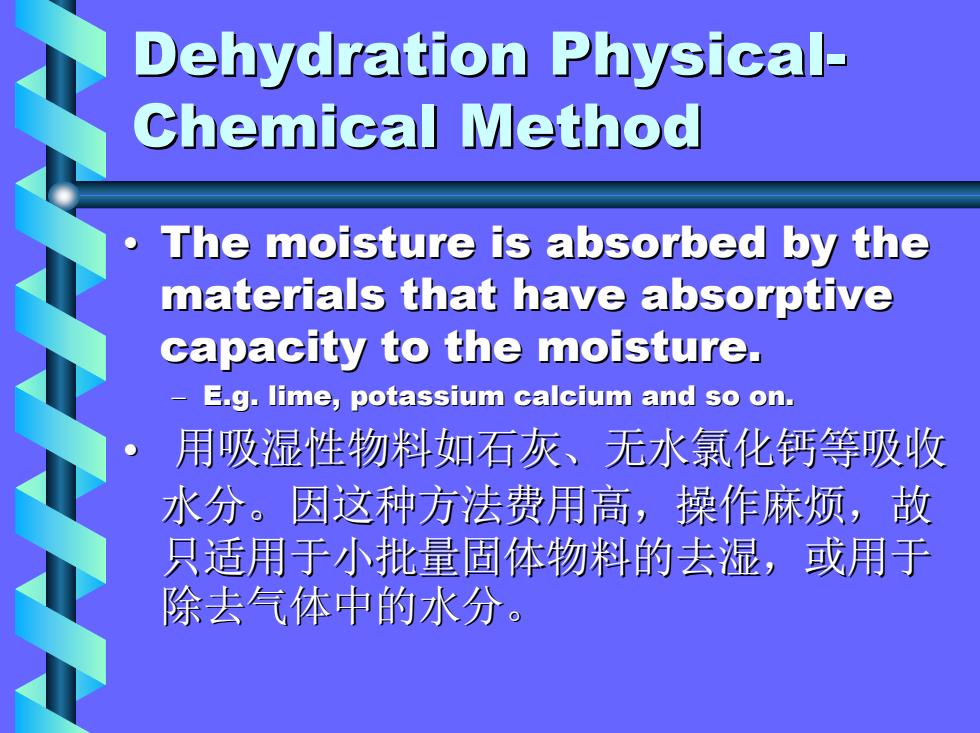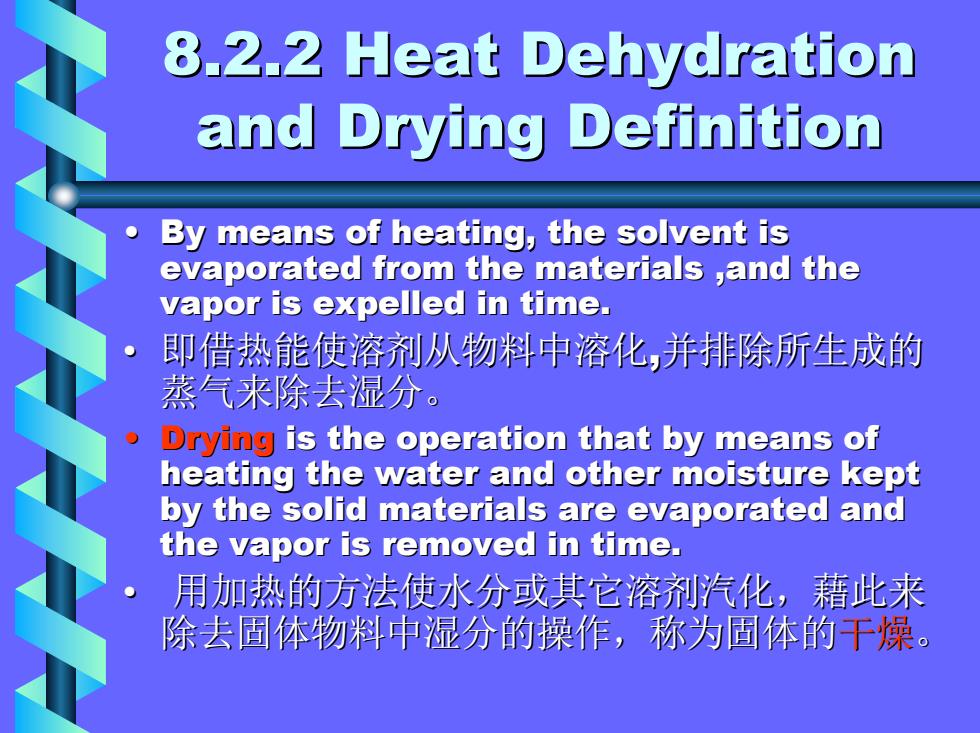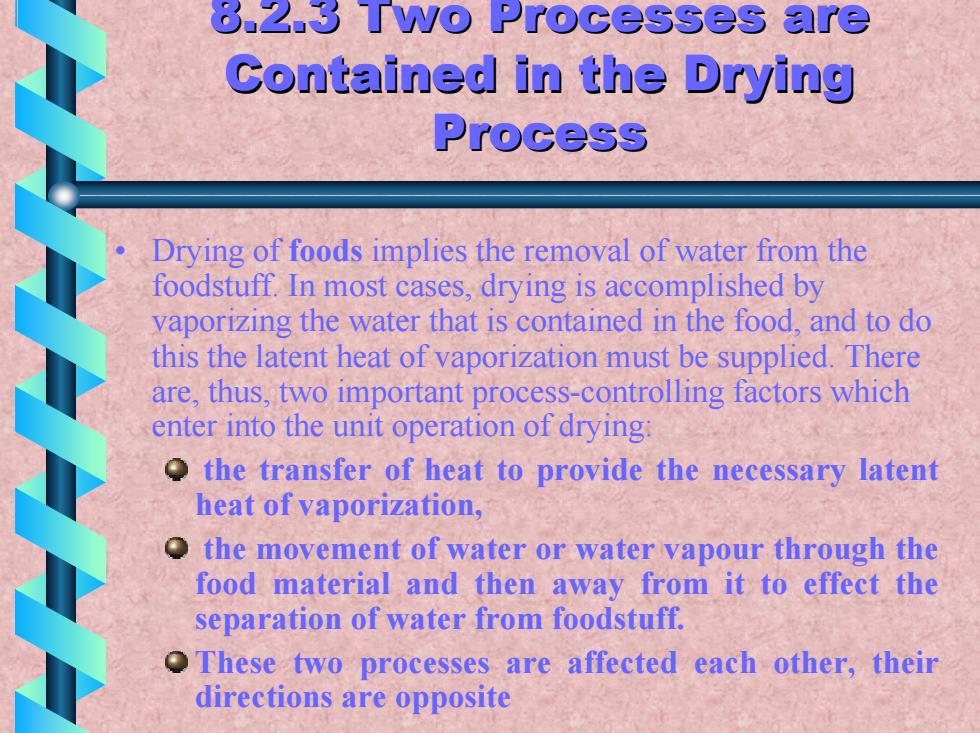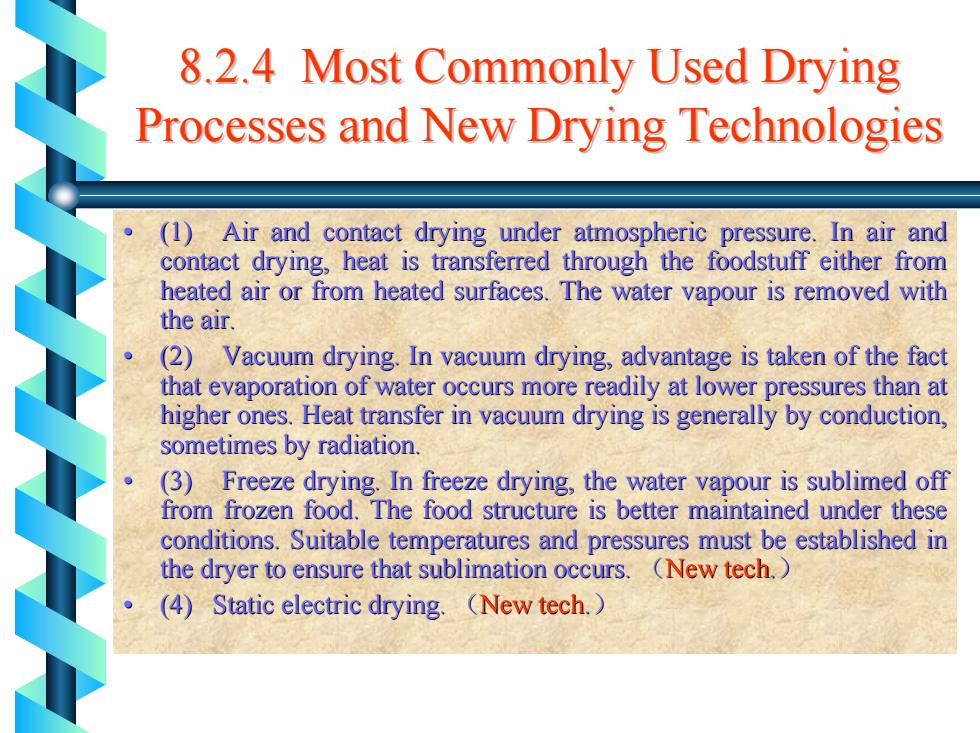
Dehydration Physical Dehydration Physical - Chemical Method Chemical Method • The moisture is absorbed by the The moisture is absorbed by the materials that have absorptive materials that have absorptive capacity to the moisture. capacity to the moisture. – E.g. li E.g. lime, potassium calcium and so on. me, potassium calcium and so on. • 用吸湿性物料如石灰、无水氯化钙等吸收 物料如石灰、无水氯化钙等吸收 水分。因这种方法费用高 水分。因这种方法费用高,操作麻烦,故 ,操作麻烦,故 只适用于小批量固体物料的 只适用于小批量固体物料的去湿,或用于 除去气体中的水分
Dehydration Physical Dehydration Physical - Chemical Method Chemical Method • The moisture is absorbed by the The moisture is absorbed by the materials that have absorptive materials that have absorptive capacity to the moisture. capacity to the moisture. – E.g. li E.g. lime, potassium calcium and so on. me, potassium calcium and so on. • 用吸湿性物料如石灰、无水氯化钙等吸收 物料如石灰、无水氯化钙等吸收 水分。因这种方法费用高 水分。因这种方法费用高,操作麻烦,故 ,操作麻烦,故 只适用于小批量固体物料的 只适用于小批量固体物料的去湿,或用于 除去气体中的水分

8.2.2 Heat Dehydration 8.2.2 Heat Dehydration and Drying Definition and Drying Definition • By means of heating, the solvent is By means of heating, the solvent is evaporated from the materials ,and the evaporated from the materials ,and the vapor is expelled in time. vapor is expelled in time. • 即借热能使溶剂从物料中溶化 即借热能使溶剂从物料中溶化 ,并排除所生成的 并排除所生成的 蒸气来除去湿分。 蒸气来除去湿分。 • Drying is the operation that by means of is the operation that by means of heating the water and other moisture kept heating the water and other moisture kept by the solid materials are evaporated and by the solid materials are evaporated and the vapor is removed in time. the vapor is removed in time. • 用 加热的 方 法使水分或其它溶剂汽化,藉 使水分或其它溶剂汽化,藉 此 来 除去固体物料中湿分 除去固体物料中湿分 的操作,称为固体 操作,称为固体 的干燥
8.2.2 Heat Dehydration 8.2.2 Heat Dehydration and Drying Definition and Drying Definition • By means of heating, the solvent is By means of heating, the solvent is evaporated from the materials ,and the evaporated from the materials ,and the vapor is expelled in time. vapor is expelled in time. • 即借热能使溶剂从物料中溶化 即借热能使溶剂从物料中溶化 ,并排除所生成的 并排除所生成的 蒸气来除去湿分。 蒸气来除去湿分。 • Drying is the operation that by means of is the operation that by means of heating the water and other moisture kept heating the water and other moisture kept by the solid materials are evaporated and by the solid materials are evaporated and the vapor is removed in time. the vapor is removed in time. • 用 加热的 方 法使水分或其它溶剂汽化,藉 使水分或其它溶剂汽化,藉 此 来 除去固体物料中湿分 除去固体物料中湿分 的操作,称为固体 操作,称为固体 的干燥

Ways of Classification Ways of Classification for Drying Process for Drying Process Classified by Pressure Classified by Pressure Atmospheric pressure drying Atmospheric pressure drying Vacuum Drying Vacuum Drying Classified by Operation Method Classified by Operation Method Batch drying Batch drying Continuous Drying Continuous Drying Classified by Mode of Heat Transfer Classified by Mode of Heat Transfer Conduction Conduction Convection Convection Radiation Radiation Dielectric drying Dielectric drying (高频干燥)
Ways of Classification Ways of Classification for Drying Process for Drying Process Classified by Pressure Classified by Pressure Atmospheric pressure drying Atmospheric pressure drying Vacuum Drying Vacuum Drying Classified by Operation Method Classified by Operation Method Batch drying Batch drying Continuous Drying Continuous Drying Classified by Mode of Heat Transfer Classified by Mode of Heat Transfer Conduction Conduction Convection Convection Radiation Radiation Dielectric drying Dielectric drying (高频干燥)

8.2.3 Two Processes are wo Processes are Contained in the Drying Contained in the Drying Process Process • Drying of foods implies the removal of water from the foodstuff. In most cases, drying is accomplished by vaporizing the water that is contained in the food, and to do this the latent heat of vaporization must be supplied. There are, thus, two important process-controlling factors which enter into the unit operation of drying: the transfer of heat to provide the necessary latent heat of vaporization, the movement of water or water vapour through the food material and then away from it to effect the separation of water from foodstuff. These two processes are affected each other, their directions are opposite
8.2.3 Two Processes are wo Processes are Contained in the Drying Contained in the Drying Process Process • Drying of foods implies the removal of water from the foodstuff. In most cases, drying is accomplished by vaporizing the water that is contained in the food, and to do this the latent heat of vaporization must be supplied. There are, thus, two important process-controlling factors which enter into the unit operation of drying: the transfer of heat to provide the necessary latent heat of vaporization, the movement of water or water vapour through the food material and then away from it to effect the separation of water from foodstuff. These two processes are affected each other, their directions are opposite

8.2.4 Most Commonly Used Drying 8.2.4 Most Commonly Used Drying Processes and New Drying Technologies Processes and New Drying Technologies • (1) Air and contact drying under atmospheric pressure. In air and contact drying under atmospheric pressure. In air and contact contact drying, heat is transf drying, heat is transferred through the foodstuff either erred through the foodstuff either from heated air or from heated surface heated air or from heated surfaces. The water vapour is s. The water vapour is removed removed with the air. the air. • (2) Vacuum drying. In vacuum drying, Vacuum drying. In vacuum drying, advantage is taken of the fac advantage is taken of the fact that evaporati that evaporation of water occurs on of water occurs more readily at lower readily at lower pressures pressures than at than at higher ones. Heat ones. Heat transfer transfer in vacuum dryi vacuum drying is generall ng is generally by cond y by conduction, uction, sometimes by radiati mes by radiation. • (3) Freeze drying. drying. In freeze drying, the water vapour is sublimed of In freeze drying, the water vapour is sublimed off from frozen food. The food struct from frozen food. The food structure is better maintained under ure is better maintained under these conditi conditions. Suitable temperatures and pressures must be establis ons. Suitable temperatures and pressures must be established in the dryer to ensure that sublimation occurs. the dryer to ensure that sublimation occurs. (New tech New tech.) • (4) Static electric drying. (4) Static electric drying. (New tech New tech.)
8.2.4 Most Commonly Used Drying 8.2.4 Most Commonly Used Drying Processes and New Drying Technologies Processes and New Drying Technologies • (1) Air and contact drying under atmospheric pressure. In air and contact drying under atmospheric pressure. In air and contact contact drying, heat is transf drying, heat is transferred through the foodstuff either erred through the foodstuff either from heated air or from heated surface heated air or from heated surfaces. The water vapour is s. The water vapour is removed removed with the air. the air. • (2) Vacuum drying. In vacuum drying, Vacuum drying. In vacuum drying, advantage is taken of the fac advantage is taken of the fact that evaporati that evaporation of water occurs on of water occurs more readily at lower readily at lower pressures pressures than at than at higher ones. Heat ones. Heat transfer transfer in vacuum dryi vacuum drying is generall ng is generally by cond y by conduction, uction, sometimes by radiati mes by radiation. • (3) Freeze drying. drying. In freeze drying, the water vapour is sublimed of In freeze drying, the water vapour is sublimed off from frozen food. The food struct from frozen food. The food structure is better maintained under ure is better maintained under these conditi conditions. Suitable temperatures and pressures must be establis ons. Suitable temperatures and pressures must be established in the dryer to ensure that sublimation occurs. the dryer to ensure that sublimation occurs. (New tech New tech.) • (4) Static electric drying. (4) Static electric drying. (New tech New tech.)